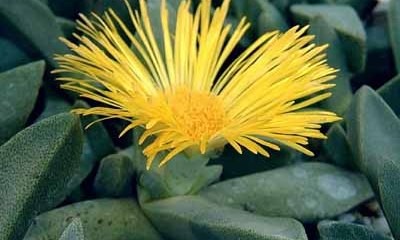Mimicry plant
(Pleiospilos bolusii)

Description
Pleiospilos bolusii, the mimicry plant, is a species of flowering plant in the family Aizoaceae, native to the Eastern Cape of South Africa, where it grows at an altitude of 750–1,100 m (2,461–3,609 ft). The species epithet bolusii honours Harry Bolus, a 19th-century South African botanist. It is a small, stemless succulent perennial growing to 8 cm (3 in) tall by 15 cm (6 in) wide, with two or four opposite grey-green leaves, quite thick, fused at the base, almost triangular, with entire margins. The leaves are longer and more angular than those of the closely related P. nelii, but in both cases the shape and texture of the leaves resemble a pile of split pebbles, possibly to deter predators. The yellow, many-petaled, daisy-like flowers emerge from the center of the leaves, and are 6–8 cm (2–3 in) in diameter - large in relation to the overall size of the plant. The flowers are often coconut-scented. The flowering period extends from August to September. The plant is one of several species cultivated for their rocklike appearance, which are sometimes collectively called mesembs. With a minimum temperature of 7 °C (45 °F), in temperate regions it is grown under glass. It has gained the Royal Horticultural Society's Award of Garden Merit. Pleiospilos is a genus of succulent flowering plants of the family Aizoaceae, native to South Africa. The name is derived from the Greek pleios "many" and spìlos "spot". The plants are also known as kwaggavy ("Quagga mesemb"), lewerplant ("liver plant"), lewervygie ("liver mesemb"), klipplant ("stone plant"), split rock or mimicry plant. Pleiospilos species have two or four opposite, very fleshy, grey-green leaves growing from a short stem that may be underground. The leaves, with their hemispherical shape and pitted texture, often strongly resemble a pile of split pebbles to deter predators. Flowers emerge from the center of the leaves, and may be very big in relation to the overall size of the plant. They reproduce both sexually and asexually. Vegetative offshoots emerge from the root system. Seed set occurs in early spring around March. The species P. bolusii and P. nelii are cultivated as ornamentals.
Taxonomic tree:







